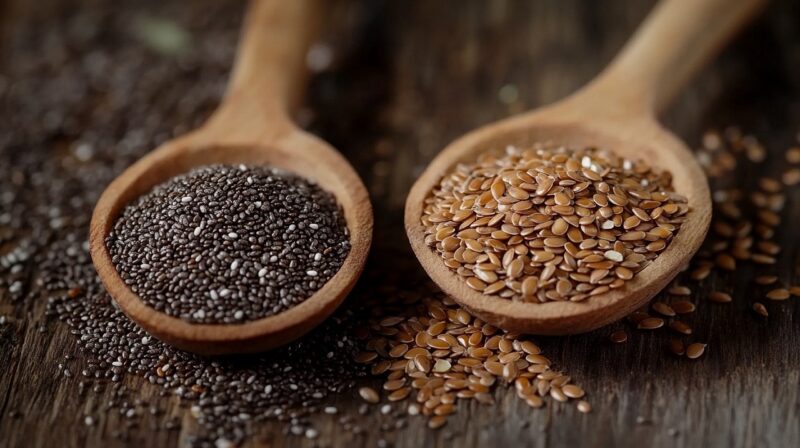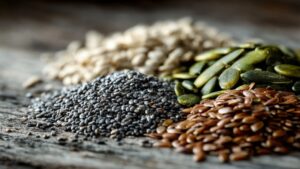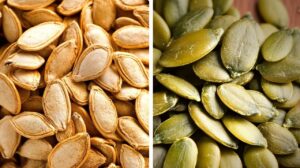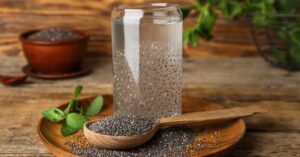Digestive strength starts with fiber. Every function in the gut—from regular bowel movement to nutrient absorption—relies on the type and quality of fiber in daily meals. Chia seeds and flax seeds both offer rich amounts of dietary fiber, but their effects inside the digestive tract are not identical.
Each seed supports gut health in its own way. Chia swells and hydrates the digestive system with its gel-like structure. Flax delivers mucilage, a natural lubricant that softens waste and promotes smooth bowel movements.
Both options bring benefits, but the choice depends on what the gut needs most.
By focusing only on digestion, bowel regularity, and gut performance, this comparison explains how each seed works inside the body. Fiber content, water absorption, microbiome support, and digestive texture form the foundation of this guide.
The goal is not to find a perfect winner—but to help identify the better option for specific digestive goals.
Fiber Comparison: Soluble, Insoluble, and Gut Function
Fiber is the most critical factor when comparing chia seeds and flax seeds for gut health. Both types of seeds offer rich fiber content, but they differ in how that fiber behaves inside the digestive system.
Total Fiber per Serving

Both seeds help move waste through the intestines, but the type of fiber they contain influences how they affect bowel movements, hydration, and stool formation.
How Chia Fiber Works in the Gut?
Chia seeds contain a balance of soluble and insoluble fiber. When mixed with liquid, they form a gel-like texture, which:
- Increases stool bulk
- Slows digestion to allow better nutrient absorption
- Keeps the colon hydrated
- Triggers intestinal movement through gentle stretching
How Flax Fiber Supports Digestion
Flax seeds contain mucilage, a sticky soluble fiber that behaves like a natural lubricant inside the gut. Mucilage:
- Softens stool and reduces strain
- Coats the digestive tract, easing irritation
- Supports smoother, more comfortable elimination
- Helps maintain intestinal lining integrity
Flax is especially useful when bowel movements feel slow or irregular due to dryness.
Digestive Outcome: Which One Helps More?
- Choose chia seeds to bulk up stool and keep the colon hydrated.
- Choose flax seeds to soften stool and ease its passage.
- Both help with regularity, but through different mechanisms.
Absorption, Expansion, and Gut Transit
Gut health depends not only on fiber content but also on how well the body absorbs nutrients and moves waste through the digestive tract. Chia seeds and flax seeds affect gut transit differently due to how they interact with moisture and how easily their nutrients are released.
Whole vs Ground: What the Gut Can Actually Use
- Chia seeds can be eaten whole. Their outer shell softens easily in liquid, allowing the gel to form even without grinding.
- Flax seeds should be eaten ground. Whole flax seeds often pass through the gut intact, which limits the release of nutrients.
- Grinding both improves absorption, but it is essential for flax to unlock its full digestive potential.
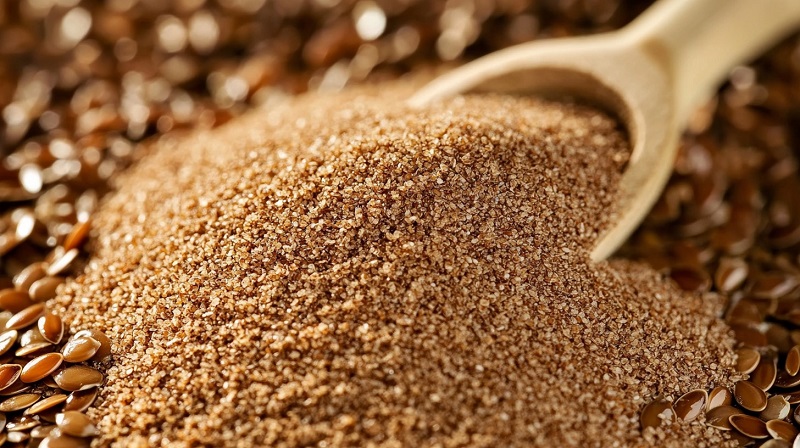
Water Absorption and Gel Formation
Chia seeds absorb water quickly and expand to many times their size.
This creates a gel-like coating that:
- Slows digestion
- Helps stool retain water
- Supports a longer feeling of fullness
Flax seeds also absorb water, but less dramatically. Instead, they release mucilage, which coats and soothes the intestinal lining.
Movement Through the Gut
- Chia’s expansion helps stimulate the walls of the intestine through volume and softness, encouraging natural peristalsis.
- Flax’s mucilage works like a glide path, easing the passage of stool through the colon without irritation or strain.
Digestive Effect in Real Terms
- For harder, dry stools: flax offers smoother transit.
- For sluggish digestion needing volume and hydration: chia supports movement with moisture and bulk.
- Both support regularity, but the mechanism differs in water behavior and nutrient release.

Prebiotic Value and Gut Microbiome Support
A strong gut depends on more than regular bowel movements. It needs a balanced and diverse community of beneficial bacteria. Chia seeds and flax seeds support this internal ecosystem by acting as prebiotics—fibrous substances that feed gut microbes and help them thrive.
The human gut contains trillions of bacteria, many of which play a role in digestion, immunity, and nutrient synthesis. Prebiotic fibers reach the large intestine undigested and serve as fuel for helpful microbes. Chia and flax both contain this fermentable fiber, which enhances microbial balance and reduces gut inflammation.
Flax seeds offer a unique advantage in this area through their high lignan content. Lignans are natural compounds that function both as antioxidants and prebiotic agents. Inside the gut, bacteria convert lignans into enterolignans, which may lower intestinal inflammation and protect the gut lining. These effects support a stable digestive environment and encourage the growth of beneficial bacteria such as Bifidobacteria and Lactobacillus.
Chia seeds also support the microbiome, particularly through their gel-forming fiber. The texture slows digestion and fermentation, offering a steady source of nutrients for gut microbes over time. This slower fermentation may reduce gas and bloating compared to rapidly fermenting fibers.
Only a few plant foods can support both digestion and microbial balance in equal measure. Chia and flax qualify due to their complex fiber structures, their anti-inflammatory compounds, and their long-term effects on microbial populations.
Key Points
- Flax lignans provide antioxidant and prebiotic benefits.
- Chia gel fibers support gradual fermentation and stable gut flora.
- Both seeds improve bacterial diversity and gut barrier integrity.
Which Works Better for What
Gut needs vary. Some benefit from added moisture, others need smoother passage or more bulk. Chia seeds and flax seeds offer different strengths that respond to those specific conditions. Matching the right seed to the right problem creates better digestive outcomes.
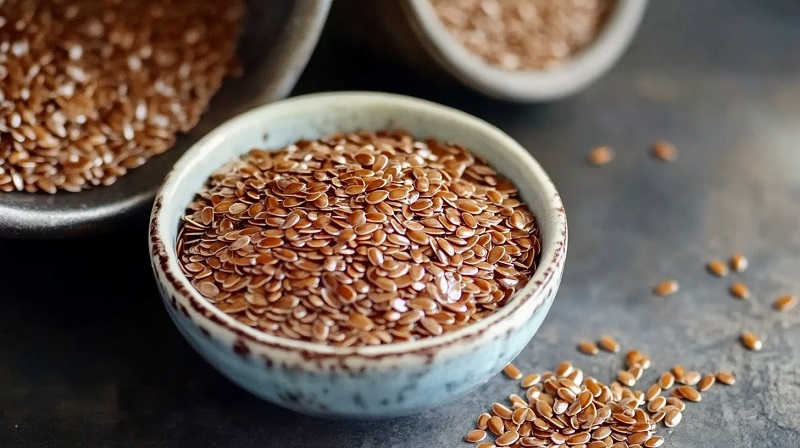
For Constipation Relief
Flax seeds offer faster results when stool feels dry or difficult to pass. Their high mucilage content creates a natural coating in the intestines, softening stool and easing its movement. Ground flax blends easily into meals and supports regularity without strain. Those who experience slow or irregular bowel patterns often notice smoother elimination when flax becomes part of the routine.
For Stool Bulk and Moisture
Chia seeds perform better when the gut needs more volume and hydration. The fiber in chia absorbs water rapidly and swells into a soft, gel-like mass. That structure holds moisture, increases stool size, and stimulates intestinal contractions. Those with slow-moving digestion benefit from chia’s ability to hydrate the colon and create gentle internal pressure.
For Sensitive or Sluggish Digestion
Chia seeds combine well with wet foods like yogurt, oats, or blended drinks. Their expansion in liquid creates a soothing texture that moves through the gut with ease.
Flax seeds, on the other hand, blend smoothly into dry ingredients and leave behind little texture. Both can be tolerated well, but those with sensitive guts may find chia’s soft bulk more comfortable, especially when digestion feels heavy or slow.
For Recipes and Consistency
Use chia in puddings, overnight oats, and soft breakfast bowls. Use flax in baked goods, cereals, or as a mix-in for dry toppings. Both improve gut response when added to consistent daily meals, but each pairs best with certain textures.
Nutritional Extras That Affect Gut Performance
Gut function depends on more than fiber. Several supporting nutrients influence how the digestive system operates. Both chia and flax seeds contain compounds that indirectly strengthen gut performance by supporting the enzymes, muscles, and cells involved in digestion.

Omega-3 Fatty Acids and Inflammation Control
Both chia and flax seeds are rich in alpha-linolenic acid (ALA), a plant-based omega-3. Omega-3s help calm inflammation in the intestinal lining, reducing irritation and supporting better absorption of nutrients. Flax contains slightly more ALA per serving, but both provide enough to make a difference in a high-fiber diet.
Inflammation in the gut interferes with digestion and nutrient uptake. ALA helps stabilize the environment, especially in people with irritable bowel patterns or food sensitivities. Flax may offer a slight edge when inflammation is the underlying issue.
Calcium and Digestive Enzyme Support
Chia seeds contain more calcium, offering about 179 mg per ounce compared to flax’s 60 mg. Calcium activates digestive enzymes and supports smooth muscle contractions in the intestines. For those who avoid dairy or follow a plant-based diet, chia offers a meaningful source of this enzyme-supporting mineral.
Lignans and Gut Cell Protection
Flax seeds deliver a powerful compound called lignans. These antioxidants help protect cells, reduce oxidative stress, and may support hormonal balance, especially during periods of digestive change. Inside the colon, lignans convert into compounds that offer cellular defense against inflammation and even early tissue damage.
Final Thoughts
Those who face multiple digestive concerns can benefit by using both seeds throughout the week. One builds structure. The other eases flow. Together, they offer a complete, plant-based way to improve gut health through daily meals.

